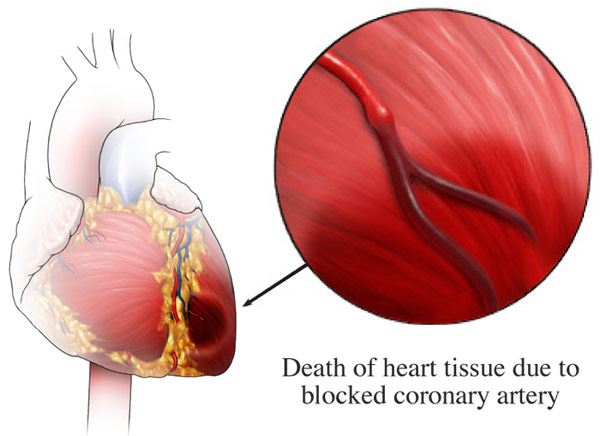Heart Attack
A heart attack is a cardiac emergency and can be fatal if not diagnosed and treated quickly. Anyone who experiences an acute onset of chest pain, fullness, discomfort or pressure; shortness of breath; pain or discomfort in one or both arms, the neck, jaw or stomach; breaks out into a cold sweat, experiences nausea, vomiting or passes out should call 911 immediately. The acute onset of these symptoms could indicate the early stages of a heart attack or of another cardiac-related condition.
A heart attack, also known as a myocardial infarction (MI), occurs when blood flow to the heart is blocked. The heart muscle requires a constant supply of oxygen-rich blood to nourish it. This oxygen-rich blood is supplied by the coronary arteries. If your coronary arteries are narrowed, due to atherosclerosis (build-up of plaque), blood flow is interrupted. If this plaque breaks loose into the bloodstream, it can completely block your blood supply. If this blood clot blocks the coronary arteries, a heart attack occurs.
The term heart attack is often used interchangeably with another term, sudden cardiac arrest (SCA). However, these conditions are not the same. In a heart attack, there is a blockage in a blood vessel that interrupts the flow of blood. Sudden cardiac arrest happens due to a malfunction with the heart’s electrical system. However, these two distinct heart conditions are linked as heart attacks increase the risk for sudden cardiac arrest. Although most do not lead to SCA, when SCA occurs, heart attacks are the common cause.

Medical Illustration Copyright © 2019 Nucleus Medical Media, All rights reserved.
Types of Heart Attack
The type of heart attack you experienced determines the treatments that your medical team will recommend. These include:
- ST- Segment Elevation Myocardial Infarction (STEMI): This type of heart attack occurs when a coronary artery is completely blocked. As a result, a large portion of the heart cannot receive blood, and the heart muscle quickly begins to die. STEMI are the deadliest type of heart attacks.
- Non-ST Segment Elevation Myocardial Infarction (NSTEMI): This type of heart attack occurs when a coronary artery is severely restricted but not entirely blocked. NSTEMIs usually cause less damage to the heart than their counterpart, STEMI.
Causes of Heart Attack
A heart attack, as previously described, occurs when the blood flow to a part of the heart is blocked. However, other conditions, traits or habits may also raise your risk for this condition. These are known as risk factors and include:
Non-Modifiable Risk Factors: These factors are irreversible and cannot be changed. The more of these risk factors you have, the greater your chance of a heart attack.
- Male gender
- Occur at any age; however, if you’re over 40 or have multiple risk factors work closely with your doctor.
- Family history/Genetics
Modifiable Risk Factors: These factors can be modified, treated or controlled through medications or lifestyle changes.
- High blood pressure
- High cholesterol
- Little to no physical activity.
- Obesity or having a body mass index “BMI” of 30 or greater.
- Long history of cigarette smoking and/or drug abuse.
- Diabetes: When your blood glucose, also called blood sugar, is too high.
- Extreme emotional stress.
- Excessive alcohol consumption over many years.
Symptoms of Heart Attack
Common symptoms of a heart attack include:
- Chest pain, fullness, discomfort or pressure.
- Discomfort or pain in one or both arms, the back, neck, jaw, or stomach.
- Lightheadedness/Fainting
- Fatigue
- Rapid heart rate (tachycardia) of over 100 beats per minute.
- Heart palpitations
- Shortness of breath
- Nausea and/or vomiting
- Sweating
Diagnosis of Heart Attack
The hours following a heart attack can be scary and confusing. Your medical team may be incredibly busy and focused, and hard-pressed to explain everything that’s happening. Ideally, you’ll be asked to describe your symptoms and have your blood pressure, pulse and temperature checked. After that, your doctor may recommend diagnostic tests. Some of the diagnostic tests and procedures include:
Treatment of Heart Attack
With each passing minute after a heart attack, more heart tissue loses oxygen and deteriorates or dies. Once the heart attack is diagnosed, treatment begins immediately, possibly in the ambulance or emergency room. Treatment options include:
Medications
The goals of medication therapy are to break up or even prevent blood clots, prevent platelets (tiny blood vessels that help your body form blood clots to stop bleeding) from gathering and sticking to plaque, stabilize the plaque, and prevent further lack of oxygen to the heart muscle. These medications must be given as soon as possible (within 30 minutes from the start of the heart attack symptoms) to decrease the amount of damage to the heart muscle.
Medication options may include the following:
- Aspirin will treat pain, inflammation, and reduce risk of a heart attack.
- Thrombolytic therapy is the administration of drugs called “lytics” or “clot busters” that will help break up or dissolve blood clots.
- Anticoagulants “blood-thinners” will help treat, prevent and reduce blood clotting.
- Other antiplatelet drugs such as brilinta and prasugrel.
- Statins will help reduce the level of cholesterol in the blood.
- Any combination of the above.
